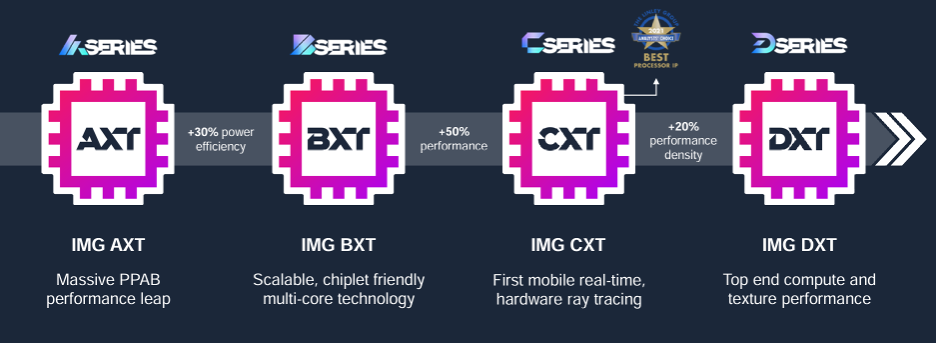Imagination Technologies unveiled the DXTP GPU at the Mobile World Congress in Barcelona, Spain. The graphics processing unit is designed for efficient graphics and compute acceleration in smartphones and power-constrained devices. The DXTP offers up to 20% better performance per watt than its predecessor, featuring 64 GPixel/s, 2 TFLOPS FP32, and 8 TOPS int8.
What do we think? Having most recently introduced desktop and automotive siblings, Imagination Technologies finalizes its D-Series era with the DXTP. The mobile GPU market has historically been bifurcated into integrated IP licensing (e.g., Arm Mali, Imagination PowerVR, AMD with Samsung) and custom in-house designs (e.g., Qualcomm Adreno). Apple silicon is an odd one, crossing the line at some point from being licensed to becoming an in-house design.
Licensing was critical for companies lacking the R&D scale to develop proprietary architectures, which is still the case in some markets, but mobile is no longer one of those. While Google still licenses, its volumes are small, so MediaTek remains the key prize in mobile. We don’t really rate the recent rumors very high that MediaTek is developing its next mobile silicon with Nvidia. Mobile smartphones are a core business for MediaTek, so why share with Nvidia? Also, we hear the company’s automotive project sees Nvidia in a dominant position, and MediaTek cannot afford that for mobile. More likely, MediaTek will act as a design partner for Nvidia, much as Samsung did for Apple in the earliest phases of the iPhone, and the key focus will be on the notebook market rather than on smartphones.
Arm Mali GPUs dominate midrange and budget devices across the mobile space, and we expect MediaTek to keep on leveraging Mali in its Dimensity SoCs. Hence, Imagination Technologies’ GPUs now prioritize automotive and IoT niches. That doesn’t mean there is no opportunity: MediaTek has used Imagination in the past, and Samsung has not been very successful with its AMD-based designs. Securing either would no doubt make IMG DXTP a success for Imagination. Imagination says the IP has already been licensed and cites Zelos (notably not a mobile device company except in the most literal sense) as a customer, as well as hinting at an undisclosed mobile segment license.
In terms of evolution, the most notable features are not in rendering but AI, with GPU features that boost its utilization for AI tasks, adding from 2 to 18 TOPS of AI performance.
AI performance of 18 TOPS is not enough for a smartphone to be considered AI-capable and, therefore, would require a neural processing unit (NPU) to get to the 40 TOPS threshold established by Qualcomm and Microsoft.
Rather, Imagination is positioning DXTP as an edge AI solution for embedded devices. Perhaps this explains how the product will be commercially viable, given the shrinking opportunities in smartphones.
It is generally believed that bringing AI into the smartphone will raise smartphone sales going forward, and Imagination will want to participate but no longer has an NPU. That might be fine—right now, NPUs have little value. They are each different and require so much hand-tuning that bringing apps to NPU is challenging for the ecosystem. Reading between the lines of their press briefing, we don’t think Imagination is developing an NPU. The best way Imagination sees to gang up processors in the future is with GPUs and high bandwidth I/O between them, and it will be interesting to see how the company progresses with its compute-focused GPUs into the future.
One area of focus seems to be memory use, notably the use of combined tiling and in-memory computing techniques. Tiling has long been the heart of Imagination’s approach to GPU and is now being optimized for broader compute workloads.
One of the biggest challenges in high-performance computing is minimizing data movement, as off-chip memory access significantly impacts power consumption and performance. NPUs have demonstrated how keeping data on-chip enhances efficiency, and GPUs are following suit by leveraging similar principles.
Rather than designing GPUs with impractical amounts of on-chip memory, tiling solutions and workload subdivision could enable efficient data management. Just as Imagination GPUs don’t store an entire frame buffer on-chip but work with small sections at a time, the same approach can be applied to computational tasks. This might make Imagination’s future GPUs more adaptable, allowing them to handle graphics and general-purpose compute workloads more efficiently.
By treating graphics as just another form of compute and optimizing data flows across workloads, Imagination’s GPU architecture could become increasingly universal—blurring the line between traditional rendering and high-performance parallel computing.

The IMG DXTP
DXTP balances performance and efficiency while supporting secure multitasking. Integrated with Imagination’s software ecosystem, it enables high-performance AI applications. As the final product in the D-Series GPU family, DXTP follows the DXD for desktops and DXS for automotive applications.
At the Mobile World conference in Barcelona, Imagination Technologies introduced its DXTP GPU, which the company says is designed to efficiently accelerate graphics and compute workloads on smartphones and other power-constrained devices. The company claims the DXTP offers improved power efficiency, delivering up to 20% better performance per watt on popular graphics workloads than its predecessor, DXT.
The global smartphone market is experiencing growth driven by cutting-edge AI features. To meet user expectations, smartphones must provide smooth interfaces, sleek designs, and all-day battery life. As the market evolves, consumers opt for premium devices that integrate advanced AI capabilities without compromising on essential smartphone qualities.
DXTP, says Imagination, balances performance and efficiency, offering up to 64 GPixel/s, 2 TFLOPS FP32, and 8 TOPS int8. It features a highly flexible, ultra-parallel compute engine running at 1 GHz, with secure GPU multitasking and the ability to run graphics and compute operations simultaneously.

The GPUs are asynchronous for everything; all operations, such as scheduling various number formats (e.g., FP16, int8, DOT8, etc.) and scalable local memory allocation, can be in-flight simultaneously.
DXTP is integrated within Imagination’s software ecosystem, which includes optimized OpenCL compute libraries, reference kits for oneAPI and TensorGraph, and PowerVR developer tools. The company believes that integration will enable developers to create high-performance AI applications on Android devices.
According to James Chapman, chief product officer at Imagination, DXTP is the result of incremental improvements that collectively achieve significant gains. The performance and efficiency enhancements in DXTP will enable future smartphones to run demanding gaming and AI applications with lower power consumption.

The DTXP 49-1536 offers 48 GPixel/s, 1.5 TFLOPS FP32 and 3.0 TFLOPS FP16, and 6 TOPS int8. The DXTP 64-2018 delivers 64 GPixel/s, 2 TFLOPS FP32 and 4 TFLOPS FP16, and 8 TOPS int8.
The company says both DXTP configurations have already been licensed.
“Zelos is integrating the advanced, power-efficient compute of Imagination DXTP into our upcoming chip,” says Cheng Chen, technical director at Zelos. “Imagination’s GPUs combine the performance of ultra-parallel processing with the flexibility that comes from a highly programmable architecture, making them the ideal platform for accelerating our AI models.”

LIKE WHAT YOU’RE READING? INTRODUCE US TO YOUR FRIENDS AND COLLEAGUES.